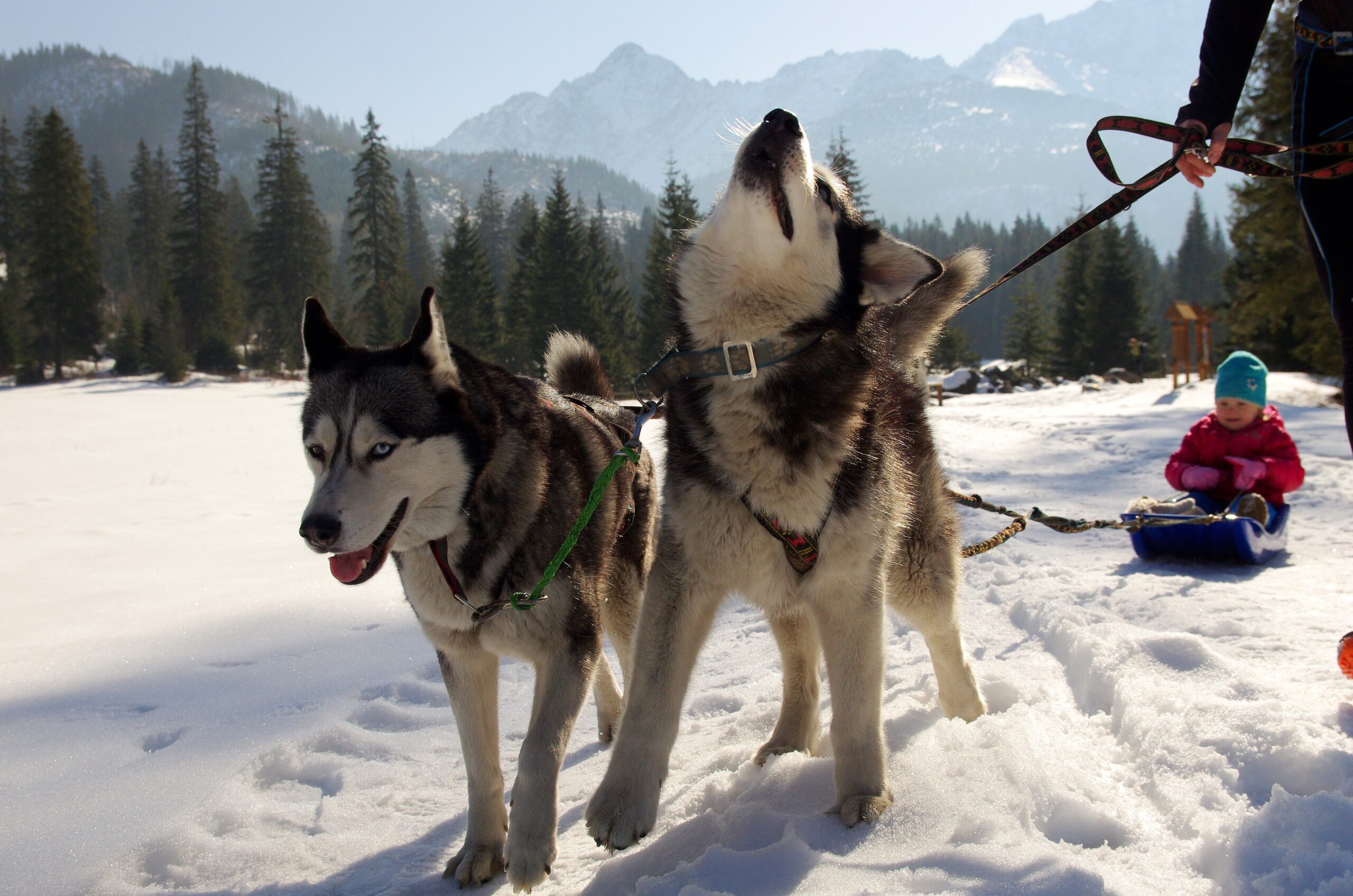Before you rescue or adopt a husky, we want to help you understand some of their tendencies. You may be familiar with their athletic prowess and tenacity in the tundra. Here is a little background information to prepare you for your new companion that could give Rudolph a run for his money in any sled race.
Huskies are known for their endurance and need for vigorous daily exercise.
Early socialization and consistent training are crucial for sled dog development.
Rescuing a Husky involves initial health checks and trust-building activities.
Providing mental stimulation is as important as physical exercise for Huskies.
Proper nutrition and preventative care are key to maintaining a healthy sled dog.
At a Glance: Adopting Purebred Huskies
Imagine the piercing blue eyes and majestic stride of a Siberian Husky, a breed synonymous with endurance and strength. These dogs aren’t just pets; they’re companions with a lineage steeped in history, each with a heart that yearns for snowy trails and the call of the wild. If you’re drawn to the spirit of the North and the companionship of a furry friend who can pull more than their own weight, then let’s dive into the world of rescuing, exercising, and training Huskies to be sled dogs.
How Husky Dogs Can Lead The Pack
Huskies are more than just a pretty face with a fluffy coat. They’re working dogs with a robust build and an innate ability to withstand cold climates. Their thick fur, powerful legs, and tireless stamina make them ideal for pulling sleds across frozen tundras. But beyond their physical prowess lies a friendly and playful temperament that endears them to humans, making them excellent companions both on and off the sled trails.
Purebreds Characteristics
What sets purebred Huskies apart is not just their stunning appearance but also their genetic makeup, which has been honed over centuries for specific traits conducive to sled pulling. They have a high energy level, an eagerness to run, and a pack mentality that makes them thrive in a team. These dogs are loyal, intelligent, and have a natural inclination to work closely with humans.
Huskies In Need
Despite their beauty and prowess, many Huskies find themselves in shelters due to the misalignment between their needs and the expectations of unprepared owners. These dogs require a dedicated handler who understands the demands of their breed – someone who can provide ample exercise, mental stimulation, and a sense of purpose. Rescuing a Husky isn’t just about saving a life; it’s about preserving the dignity of a breed that has served humankind faithfully for generations.
First Steps After Rescuing a Husky
When you bring a rescued Husky into your life, it’s not just about giving them a new home, but also a new start. The transition can be overwhelming for both of you, but with patience and understanding, you’ll lay the groundwork for a strong bond.
Health Check: Prioritizing Your Husky’s Wellbeing
Schedule a vet appointment for a full check-up.
Update vaccinations and discuss a schedule for regular preventative care.
Assess diet and make adjustments to suit their energy needs.
Before you embark on any training or exercise regimen, make sure your Husky is healthy. A thorough vet check-up will reveal any underlying issues that could affect their ability to train or exercise. It’s also the perfect time to discuss nutrition, as these high-energy dogs have specific dietary needs.
Establishing Trust Getting to Know Your New Rescue
Your Husky may be cautious at first, which is entirely normal. Spend time with them, engage in gentle play, and offer treats to build a positive association. Trust is the cornerstone of any training, especially for a working dog like a Husky.
Remember, every Husky is an individual, and while they may share breed characteristics, they’ll also have their own quirks and preferences. Learn to read their body language and respond to their cues. With time, your Husky will learn to trust and look to you for guidance.
Now that you’ve laid the foundation of trust and verified your Husky’s health, it’s time to focus on their purpose and passion: sled work. Training a Husky to pull a sled is a journey that taps into their natural instincts, but it requires dedication and a systematic approach.
Training for Sled Work
Transitioning your Husky from a rescue to a sled dog is a process that can be immensely rewarding. It’s a chance to channel their boundless energy into a discipline that’s part of their heritage. Let’s explore how to harness your Husky’s potential and guide them into becoming a sled dog, step by step.
Fundamentals: Fulfilling Your Husky’s Potential
The first step in sled dog training is to get your Husky accustomed to wearing a harness. This is the gear they’ll be wearing when they pull a sled, so it’s essential for them to feel comfortable in it. Start with short periods of wearing the harness during walks, gradually increasing the time as they get used to it. Once they’re comfortable, you can attach a lightweight object, like a small tire, to give them the feel of pulling weight.
Team Building : Socialization and Integration
Huskies are pack animals, and working as part of a sled team comes naturally to them. However, it’s vital to introduce your Husky to potential teammates in a controlled environment. Socialization is key, and you want to ensure that your Husky can interact positively with other dogs. Group play sessions, shared walks, and supervised interactions can help establish a pecking order and build camaraderie among the team.
Moreover, establishing yourself as the pack leader is crucial. Your Husky needs to respect and follow your commands, especially when they’re part of a sled team. Consistent leadership and clear communication will help your Husky understand their role within the pack.
Training: The Basics of Sled Dog Commands
With the fundamentals in place, it’s time to introduce sled dog commands. These are the cues that you’ll use to direct your Husky when they’re pulling a sled. The basic commands are ‘Hike’ (to start), ‘Whoa’ (to stop), ‘Gee’ (to turn right), and ‘Haw’ (to turn left). Start by using these commands during walks, rewarding your Husky for responding correctly. Consistency is key, so use the same commands every time, and be patient. It may take a while, but with repetition, your Husky will start to understand and follow your directions.
Advanced Sled Dog Training Approaches
Once your Husky has mastered the basics, it’s time to step up the training. Advanced sled dog training focuses on building endurance, strength, and the ability to handle different weather conditions.
Endurance Building: Training for Longer Runs
To build endurance, gradually increase the distance and weight your Husky pulls during training sessions. This should be done over several weeks or months to prevent injury and to allow your dog’s muscles to develop properly. Mix in varied terrain and include hills to challenge your Husky and improve their strength. Always monitor your Husky’s condition during these exercises to ensure they’re not overexerted.
Weather Acclimatization: Brrr- Helping Your Husky Toughen Up
Sled dogs often work in extreme conditions, so it’s important for your Husky to be comfortable in different types of weather. Introduce them to training sessions in the cold, snow, and wind, always ensuring their safety and comfort. Proper gear, like booties to protect their paws, can help prevent frostbite and injuries. Remember, acclimatization takes time, so don’t rush the process.
Proper Nutrition and Care: Fueling Your Husky
The physical demands of sled dog training require a diet that can support your Husky’s energy needs. Let’s take a closer look at what fuels these athletic canines.
Dietary Essentials for Hard-working Breeds
A Husky’s diet should be rich in proteins and fats to provide the energy necessary for pulling sleds. High-quality commercial dog foods designed for active breeds or working dogs are a good choice. You can also consult with a veterinarian to create a customized diet plan. Be sure to provide fresh water at all times, especially after exercise sessions.
Moreover, the timing of meals is important. Feeding your Husky several hours before training can prevent digestive discomfort while they’re working. And after a strenuous workout, a meal can help with recovery.
Preventative Is The Best Medicine: Keeping Your Husky in Tip Top Shape
In addition to a proper diet, regular veterinary check-ups, vaccinations, and parasite control are essential to keep your Husky healthy. Pay attention to their paws, which can be prone to injuries from running on rough terrain. Regular grooming is also important, as it helps to maintain their coat and skin health, and provides an opportunity to check for any lumps, cuts, or sores.
Training a Husky for sled work is not just about physical preparation; it’s about creating a deep bond between you and your dog. It’s about understanding their needs and channeling their natural instincts into something remarkable. With patience, consistency, and care, you’ll be able to watch your Husky transform into a confident, happy sled dog, ready to take on the trails with you.
FAQs: Understanding Huskies Better
It’s clear that Huskies are a unique breed with specific needs and characteristics. As such, they often prompt a number of questions from potential owners and enthusiasts. Let’s address some of the most common queries to help you understand these magnificent dogs better.
Huskies are not just any dog; they’re a commitment, a lifestyle, and a passion. The journey with a Husky is one filled with energy, challenges, and immense rewards. Whether you’re considering rescuing a Husky, already have one, or simply admire them from afar, knowing more can only deepen your appreciation for this breed.
With their thick coats and boundless stamina, Huskies have captivated the hearts of many. But with that fascination comes responsibility. Let’s delve into the essentials of what it takes to care for these Arctic adventurers, ensuring that both you and your Husky can enjoy a fulfilling life together.
Regular exercise is essential for Huskies, with a minimum of two hours per day recommended.
Huskies can be challenging for first-time dog owners due to their high energy and independent nature.
While Huskies are built for cold climates, they can adapt to warmer environments with proper care.
A diet rich in proteins and fats is crucial for Huskies, especially when they’re active or training for sled work.
Training a Husky to be a sled dog starts with building trust, introducing them to a harness, and teaching basic commands.
How Often Do Huskies Need to Workout?
Huskies are a powerhouse of energy, and they require a significant amount of exercise to keep them happy and healthy. A minimum of two hours of vigorous activity per day is a good benchmark. This can include running, hiking, playing fetch, or training for sled work. Without ample exercise, Huskies can become bored and destructive, so it’s essential to keep them engaged physically and mentally.
Are Huskies Suitable for First-Time Dog Owners?
Huskies can be a handful, especially for first-time dog owners. They are known for their intelligence, independence, and occasional stubborn streak. This combination requires a confident owner who can provide firm, consistent training and won’t be outwitted by their clever Husky. If you’re new to dog ownership but set on a Husky, be prepared to invest time in learning about dog training and behavior.
Can Huskies Take the Heat?
While Huskies are bred for the cold, with the right precautions, they can adapt to warmer climates. It’s crucial to provide them with plenty of shade, air conditioning, and water to prevent overheating. Exercise should be done during the cooler parts of the day, and you should always be on the lookout for signs of heat exhaustion. Remember, Huskies will still shed their thick coats, so regular grooming is a must to help them stay cool.
However, just because a Husky can adapt doesn’t mean it’s ideal. These dogs are happiest in cooler environments where they can frolic and play without the risk of overheating. If you live in a hot climate and are considering a Husky, you need to be extra vigilant about their care.
What Should I Feed My Husky?
Huskies are athletic dogs that need a diet to match their high energy levels. They require high-quality dog food that is rich in proteins and fats to fuel their active lifestyle. The exact amount and type of food will depend on their age, size, activity level, and overall health. It’s always best to consult with a vet to tailor a diet plan specific to your Husky’s needs.
Because Huskies are prone to obesity, it’s important to monitor their food intake and avoid overfeeding. Treats should be given sparingly and ideally as a reward for good behavior or during training sessions. Always ensure that your Husky has access to fresh water, especially after exercise or in hot weather.
When it comes to feeding routines, consistency is key. Feeding your Husky at the same times each day can help regulate their metabolism and digestion. And as with any dog, sudden changes in diet should be avoided or implemented gradually to prevent gastrointestinal issues.
Feed high-quality dog food suitable for an active breed.
Consult with a vet to determine the best diet for your Husky’s individual needs.
Monitor food intake to prevent obesity, and provide treats in moderation.
Keep a consistent feeding schedule to support your Husky’s digestive health.
Always have fresh water available, particularly after exercise and in hot weather.
How Do You Start Training a Husky to Be a Sled Dog?
Training a Husky to be a sled dog taps into their natural instincts and can be an enriching experience. Start by fostering a strong bond and establishing trust. Introduce your Husky to a harness and let them get comfortable wearing it during walks. Gradually attach light weights, like a small tire, to accustom them to the sensation of pulling.
Next, teach them the basic sled commands: ‘Hike’ to start, ‘Whoa’ to stop, ‘Gee’ to turn right, and ‘Haw’ to turn left. Consistency in command usage is crucial for clarity and effective training. Reward your Husky for following these commands correctly, and be patient as they learn.
As your Husky becomes more comfortable with the basics, you can start to increase the challenge by introducing them to a sled and working on building endurance. Remember, every Husky is different, and training should be tailored to their pace and abilities. With time, patience, and consistent training, your Husky can become an excellent sled dog.
Finally, never forget the importance of fun in training. Your Husky should enjoy the process, and so should you. Make each session a game, and celebrate every milestone together. That’s the key to a happy and well-trained sled dog.
For rescue related information and tips, check out RescuesRSuper.com where you can learn more about some of the cast members in the upcoming animated series featuring Beefy the Beefcake and other great rescue animals!






